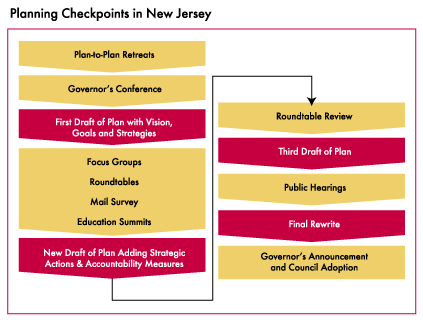New Jersey devoted three years—from October 1994 to October 1997—to creating an overarching statewide strategic plan for all the arts. Entitled Arts Plan New Jersey: Toward a Thriving New Jersey, this statewide cultural plan has no end-date and is intended to be “evergreen” for as long as it maintains its relevance. New Jersey’s admirably inclusive planning process eventually encompassed some 2,200 participants statewide, and was created in cooperation with New Jersey Network Foundation (NJN), a long-time partner in arts promotion.
Arts Plan New Jersey is very broad in scope, articulating a vision for the arts in all of New Jersey, and identifying roles that can be played by the state arts agency as well as other cultural organizations. This comprehensive effort provides a framework for the New Jersey State Council on the Arts, as well as other cultural agencies in New Jersey, to formulate and adopt individual plans that complement and advance a broader statewide vision.
Although the process was lengthy, it followed a fairly direct route:

The expense of the overall statewide plan was quite large, some $320,000. Most of this was spent on the launching event, the Governor’s Conference on the Arts—Arts in Focus III: Taking Hold of Our Future ($266,000)—a three-day meeting with 450 participants including leaders from business and industry, the media, education, technology, the arts and government. Most of that budget came from outside sources ($258,000 from corporations, foundations, NJN) plus earned income from registration fees. The funds eventually spent directly by the New Jersey State Council on the Arts (on the statewide plan and its own individual agency component) totaled a more modest $53,000 and came primarily from the agency’s annual appropriations spread out over three years.
With an eye toward adaptability, the agency made a conscious decision to apply no end-date to the plan. Instead, the plan presents long-term goals and major statewide strategic objectives. The agency then creates in that context its own long-range plan outlining its leadership roles in achieving Arts Plan along with annual program plans that allow it to make mid-course corrections, and to create a more detailed layer of measures including specific “targets, indicators and baseline data.” To date, this has kept the plan from becoming “so many dusty pages on a shelf.”
The long planning period, plus the numerous contacts with constituents, gave the agency the opportunity to create a vision and a set of goals through a process of give-and-take. As soon as the agency decided on one avenue to pursue, it would hold a public session or a roundtable discussion for feedback, adjust course, and solicit and receive feedback again. Finally, a strong consensus was reached on what became the plan’s central vision with six major goals and eight strategic objectives.
The effort spent on gathering data resulted in two major discoveries. The first was the predominant interest in the issue of arts education. “We were astonished by the relentlessness of this issue on people’s minds,” says Miller. The other surprise was the enthusiasm and willingness of people not formally involved with the agency or the arts to help. Miller cites this as one of the real benefits to opening up the planning process. “So many people said to us, ‘Gosh if you’d just asked me I’d have been happy to….'” This is also one byproduct of planning in a very densely populated state where inescapable proximity nurtures complicated and interconnected relationships.
|
Therefore, it is no surprise that partnership building became the major cornerstone of the plan, and is the principal means by which the agency develops and administers its programs. “Planning and partnership are our two mantras,” says Miller. With the idea of inclusiveness in mind, the agency also created one of the more clever and unusual aspects to its plan—a clip-out, returnable “endorsement” form. Included as part of the planning brochure, this form has been sent to 48,000 citizens so far and mailings of another 14,000 copies are expected over the next two years.
Readers are also asked to identify two goals and two strategic objectives in which they would like to become involved. Every respondent is added to a database and thereafter receives materials appropriate to the interests identified in the endorsement. The endorsement form was the result of an idea that emerged during the Governor’s Conference, when journalist and Baptist minister Willie Smith encouraged arts leaders to lift a page from the Civil Rights movement and “sign ’em up.” The brochure is one of four versions of the plan. Other versions include an 18-page Plan in-Brief, a 32-page executive reader, and the full document with appendices.
The biggest challenge posed by planning was its complexity and the fact that it was a very labor-intensive process. On the other hand, the agency points to the process itself as the most important element of planning. “Planning brought people together and started to make things happen. It showed the people of New Jersey that we had a new alignment with public purpose and benefit,” explains Miller. “Once the snowball of support began, good things just started happening by themselves.” It is hard to argue with Miller’s assessment, since the galvanized public support and advocacy for the arts initiated by long-range planning led to three consecutive years of increased legislative appropriations for the agency.